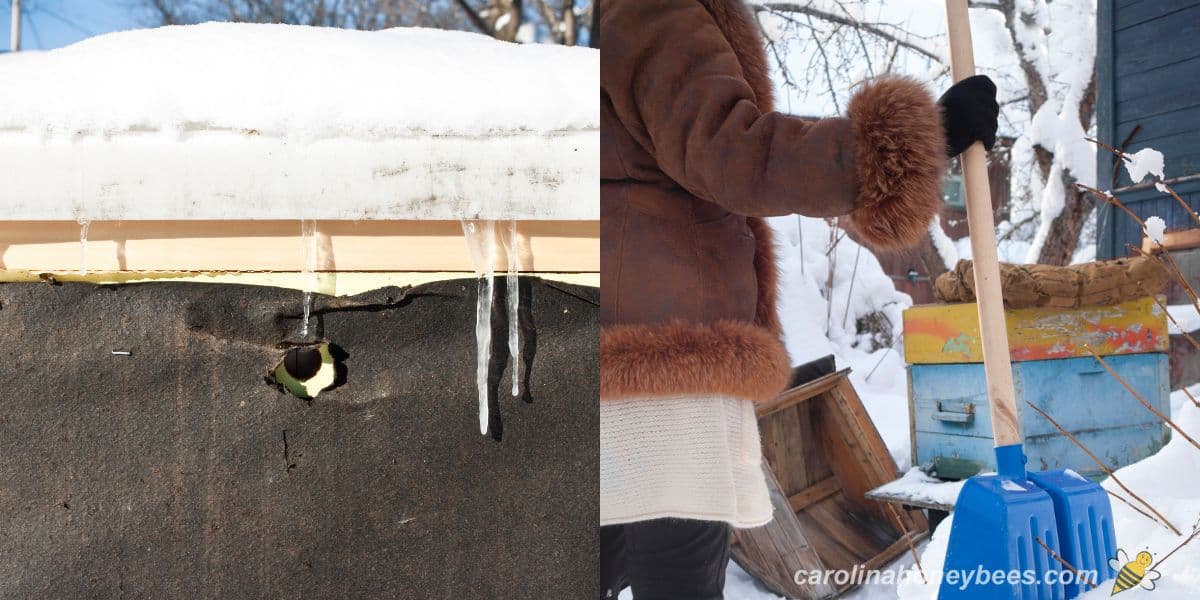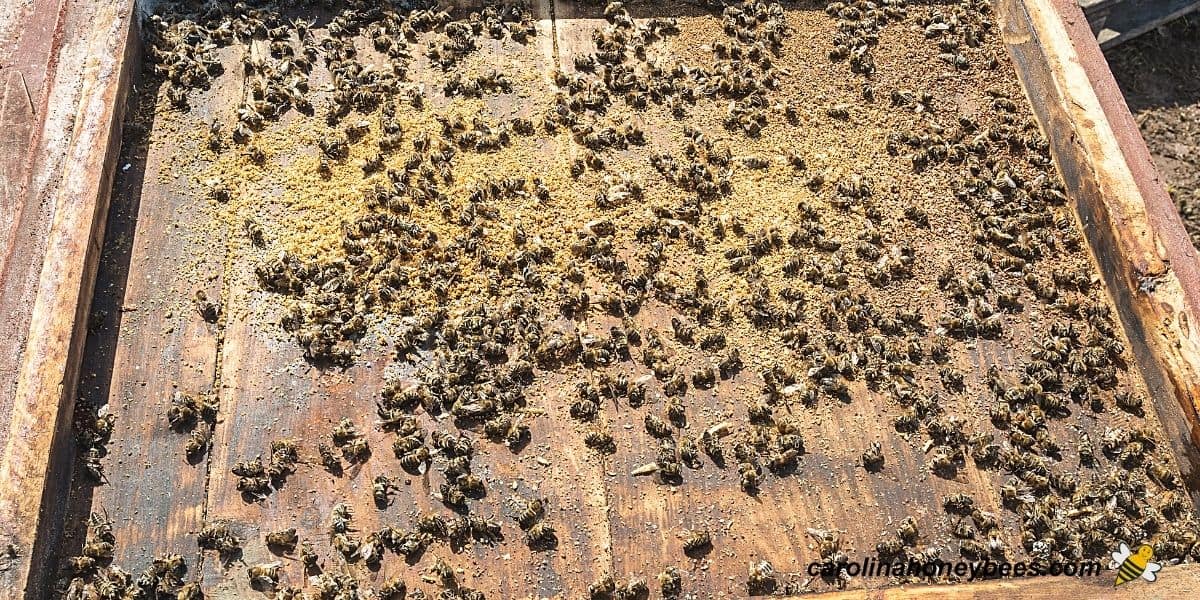[ad_1]
This post may contain affiliate links. As an Amazon Associate, I earn from qualifying purchases. Please read my disclosure.
One may think that Winter beekeeping tasks consist of sitting around the fire waiting for Spring. It is true that the cold months are not an active time for most beekeepers. But, beekeeping in Winter does not mean that we forget about the hives completely. In fact, nothing could be farther from the truth. Beekeepers spend the Winter months thinking about their bees and hoping that the hives are doing well.

Being a beekeeper means tending to the needs of your colonies throughout the season. Practicing good beehive management in starts and stops does not help you have productive hives. You have to learn – when to help and when to leave the bees in peace.
Winter Beekeeping Hive Management
Winter in the bee yard is typically a slower time with less activity for the bees and the keeper. But, of course we worry and hope that all is well.
Observe the hive entrances on warmer days. Do you see a few bees bringing in pollen? That’s a good sign.
If one colony has no activity while all the others are busy, you may need to do a quick check. Just pop the top and look in (with your veil on of course).
Hopefully, you can see some bees clustered together down in the hive. If they seem okay – don’t disturb them. Some types of honey bees fly at cooler temperatures (due to genetics).
Take a walk through the bee yard to check that entrance reducers are not plugged and that mouse guards are still in place. Don’t be alarmed at a few dead bees.
The older bees begin to die and cold temps may prevent workers from clearing out the dead. You don’t want the bodies to block your reduced entrances. Has your region experienced snow or ice? If so, check the hive opening for snow or ice.

Winter Hive Inspections
If your hives were properly winterized in the Fall, the best plan is to leave them mostly alone. True hive inspections (like those done in Summer) should not be necessary.
A quick peak in the top of the hive tells if your bees need more food. If you see lots of bees at the top of the box and no honey stores in the frames, it’s time for some emergency winter feeding.
Other options include fondant, winter patties (with or without pollen), and candy boards made of sugar placed on hives with borderline food stores.
Winter is not the time to be feeding liquid syrup to your hive. No sugar water in cold weather.

Winter DeadOuts
When a colony dies it is often called a “dead out”. There are many reasons bees die in Winter. The cold months are a difficult time for a honey bee colony.
We all struggle to keep bees alive over Winter and have strong Spring colonies but hives die. Too little food, too little food in the right place, poor quality queens, extreme moisture all play a role.
Some of the problems we can work to avoid and some are out of our control. Try to not be too discouraged when you lose hives over Winter. Unfortunately, this is a common problem for all beekeepers.

Winter Apiary Guidelines
Beekeeping tasks performed in the apiary before late Fall have a big impact on Winter colony survival rates. Your Winter beekeeping strategy should build upon good Fall work.
- prepare your hives with sufficient food before cold arrives
- wrap hives with insulation in cold regions but ensure adequate ventilation
- combine any hives that are low on population or weak
- Store unused equipment (honey supers etc.) and order supplies if needed
- examine hive entrances regularly to ensure they are not clogged
- don’t open the hive when temps are cold
- if your bees do not have stored pollen – consider adding a pollen patty in late Winter
Fall feeding of colonies in need may be necessary. Not every colony will need this extra attention. However, some will not survive otherwise. Feeding bees sugar water in a 2:1 ratio increases storage.
Doing so can be considered extra insurance to prevent starvation. If the bees don’t need them – great. This worse thing you have done is waste a little sugar.
Do you need to wrap your hive? Beekeepers in very cold regions may desire wrapping their hives with some type of beehive insulating material. However, that is unnecessary for those that are not in extreme cold locations.
Any unused boxes and other supplies should be safely put away. Find a good place to store your beekeeping equipment so it will be ready to go next Spring. Does it mean repair? This is a good time to do so.
Healthy Winter Colonies
Strong, healthy honey bees colonies with good food reserves have the best chance of survival. Most Varroa mite treatments need to be completed in late Summer-early Fall at the latest. Yes, it can be too late – don’t delay testing for varroa and treatment if needed.
This gives healthy nurse bees a chance to rear strong healthy fat Winter bees. They will sustain the hive until Spring. Sick mite infested colonies will not raise strong bees for Winter.
What to Expect from Winter Beehives
The beehive in winter is much different than a summer hive. During Winter (in most locations) the days of bees making honey are over. Instead, the honey bee colony is focused on survival.
Winter bees are not very active. On cold days, bees cluster together to stay warm and depend on constant contact with stored honey.
Honey bees start to form a cluster when the temperatures fall to around 57° F. On warmer days, you may see some bee flight. This is especially true if your beehive is placed in an area with warm afternoon sun.
Don’t be alarmed to see short periods of intense bee activity at the hive entrance – it’s probably just a “potty break”. It could also be an small orientation flight as a few new bees are produced in late Winter.
Don’t panic if you do not see activity on cool days. The bees may not want to come out and be chilled. Some hives fly on cool days and some do not. This is due (in part) to the genetics of the colony.
In general, Winter is not the time for hive inspections. Do not open the hive on cool days without a darn good reason. There is no need to stress the colony unnecessarily.
How long your bees experience cold conditions depends on your location. Some regions have long cold Winters and others experience a much shorter period of true Winter.

Things Beekeepers Should Do During Winter
Use the Winter months to prepare yourself and your bee yard for Spring. It is a good time to review some beekeeping books. No one knows it all, it is good to learn new viewpoints.
Perhaps you can travel to beekeeper meetings and get new ideas for ways to help your colonies. Consider taking a beekeeping class.
Repairing and painting beehives and equipment should be done during this time. It will come in handy when those colonies begin to grow.
As late Winter progresses, some beekeepers choose to feed their bees a protein supplement or pollen patty. You can make your own pollen patties if you wish.
Order bees and new equipment now. If you know that you want to order bees, do not procrastinate. Honey bees are best ordered in December and January for Spring pickup.
Check the hive entrances to ensure they are open so the bees might take a cleansing flight on a warm day. Watch for any hives that might turn over in storms and check food stores when weather permits.
FAQs
Winter is not the time to start a beehive if you live in a cold region. However, beekeepers do have some tasks to perform while the bees are nestled inside the hive.
We have several apiary tasks to complete including monitoring the amount of honey stored in the hive.
The queenless hive is certain to die over Winter. As her workforce dies off, there will not no new adults to take their place.
Hives should not be opened during Winter cold unless absolutely necessary. Even a few minutes of cold can kill developing brood.
Final Thoughts
For those of us who live in the South (USA), Winter beekeeping can be a beautiful thing. Finally, I can wear my beekeeping suit without fearing heat stroke.
However, even Southern locations can experience cold temperatures and resulting colony loses. There are challenges for every beekeeper – no matter the location.
You may find yourself doing risky hive procedures to keep the bees alive if you failed to get them ready for Winter in time.
Winter beekeeping will have its share of disappointments but those colonies that make it through will hopefully be healthy and ready to go in the new year.
Resources
[ad_2]


